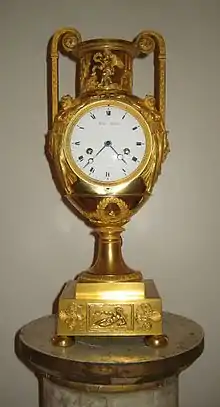
Mantel clock with mercury gilding in the shape of an urn (around 1800) by Julien Béliard, Paris, maître horloger recorded on the rue Saint-Benôit and rue Pavée in 1777, still active in 1817, or Julien-Antoine Béliard, maître horloger in 1786, recorded on the rue de Hurepoix, 1787–1806.
Mercury silvering or fire gilding is a silvering technique for applying a thin layer of precious metal such as silver or gold (mercury gilding) to a base metal object. The process was invented during the Middle Ages and is documented in Vannoccio Biringuccio's 1540 book De la pirotechnia.[1] An amalgam of mercury and the precious metal is prepared and applied to the object which is then heated, sometimes in oil, vaporizing most of the mercury. The technique is dangerous since mercury is highly toxic, especially in its vapor phase. Mercury silvering can be detected through a variety of methods.
The technique was also used in Asia, for example tokin plating in Edo-period Japan.[2]
See also
- Mercury glass, internally silvered decorative glass products named for their resemblance to mercury
- Liquid-mirror telescope, may use a layer of reflective mercury
References
- ↑ Mercury Silvering, archived from the original on March 4, 2005, retrieved 2010-02-12.
- ↑ Susan La-Niece – Metal Plating and Patination: Cultural, technical and historical 1483292061 2013 "During the Edo period mercury gilding, or tokin, was common. The Bankin Sugiwai Bukuro (Yarai 1732) describes mercury gilding thus: The objects to be plated are washed and then polished with a bamboo brush and powdered charcoal."
This article is issued from Wikipedia. The text is licensed under Creative Commons - Attribution - Sharealike. Additional terms may apply for the media files.